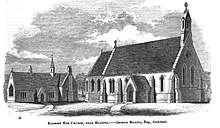Arthur Billing
Arthur Billing FRIBA (1824–1896), was a British architect.
Arthur Billing | |
|---|---|
 St John the Baptist, Kidmore End, Oxfordshire (1851–52), designed by Arthur Billing | |
| Born | 28 January 1824 |
| Died | 13 April 1896 (aged 72) 5 Peterboro-villas, Kings-road, Fulham, Middlesex |
| Nationality | British |
| Occupation | Architect |
Arthur Billing was born in Reading, Berkshire in 1824[1] and educated at Reading School. He was the son of Richard Billing (1784–1853) and the brother of Richard (1814–1884) and John Billing (1817–1863), all surveyors and architects.[2] He married in 1855 and died on 13 April 1896 in Fulham.[3]
Billing worked in the office of the well-known Gothic Revival architect, Benjamin Ferrey, in London from 1847 and commenced independent practice in 1849, his office being at 4 Beaufort-buildings on The Strand[4] and then at 10 Buckingham Street, Adelphi.[5] In 1851 he read a paper "On mural painting and the decorations of churches generally",[6] mainly historical but ending with a plea for the increased use of painted decoration.[7] He worked in partnership with Arthur Shean Newman (1828–1873)[8] as Newman & Billing at 185 Tooley Street, Southwark from 1860 until Newman's death, when he took on Newman's son, Arthur Harrison Newman (1855–1922), as his apprentice.[9]
Both on his own and in partnership he built and restored mainly churches in London[10] and the south of England. An early commission, designed in Early English style with simple lancet windows, was the church of St John the Baptist, Kidmore End, Oxfordshire,[11] close to Billing's home town of Reading. In 1868 he was commissioned to design the English Church in Meiringen, an Alpine resort in Switzerland. However, he also designed warehouses on the River Thames and the four-storey Westbourne Hall (1860–61) with a facade decorated with theatrical busts as an extension to the Bayswater Athenaeum at 26 Westbourne Grove.[12] He served as Surveyor to Guy's Hospital[13] and, until 1884,[14] to St Olave's (Southwark) District Board of Works.
In 1890 he took his son Arthur Ernest Billing (1857–1920) into partnership; they were joined by Joseph William Rowley in 1893, the practice title then becoming Arthur Billing Son & Rowley. Billing retired in 1894.[15]
References
- Baptised on 5 March 1824 at Saint Giles, Reading
- Directory of British Architects 1834–1914, Vol. 1, pp. 179–180, ed. Antonia Brodie (2nd edition 2001)
- England & Wales, National Probate Calendar (Index of Wills and Administrations), 1861–1941. Obituary in Journal of the Royal Institute of British Architects, Volume 3, p. 436 (1896).
- An Incorporated List of Members, Etc., of the Several Learned Societies for the Promotion of Architecture and Civil and Mechanical Engineering, John Weale p. iv (1854)
- London Royal Blue Book p. 431 (1860)
- Paper read at the Architectural Association on 14 March 1851 and published in The Civil Engineer and Architect's Journal, Volume 14, pp. 195–197 and 205–209, (1851). "The usual mode of decorating the roofs and ceilings of churches was by an azure ground, studded with golden stars, which was common, from the earliest periods, as a natural and symbolical allusion to the heavens.... In small country churches it was more usual to find a flower, consisting of four or more leaves, placed at the intersections of the ribs; though the symbols of the Evangelists, the Lamb and the Flag, together with a great variety of such designs, were introduced, being illuminations in colour, and gilded."
- ‘All its glory is from within’: the importance of colour in church interiors, 1840–1903, James Bettley, in 'Ecclesiology Today', Issue 45 (January 2012)
- See Oxford Dictionary of National Biography for John Newman and his son, Arthur Shean Newman
- Directory of British Architects 1834–1914, Vol. 2, p. 252, ed. Antonia Brodie (2nd edition 2001)
- Chapter 24, note 4 of 'The I'Ansons: A Dynasty of London Architects & Surveyors' by Peter Jefferson Smith (2019) notes that Arthur Billing undertook repairs to the gallery of St Magnus the Martyr in the City of London in 1886, not I'Anson as speculated by Pevsner/Bradley in their entry for this church. See also Billing's letter in The Builder of 31 August 1878, p.922, on the subject of 'The blackness of St Paul's' in which he states that he was at "present engaged on the restoration of the steeple to the parish church of St John's Horselydown (sic), Southwark".
- The Civil engineer and architect's journal, vol. 14 p. 534 (1851) and vol. 15 pp. 4–5 (1852). Billing enhanced the interior decoration of the chancel in 1871: The Building News, vol. 20, p. 38 (1871)
- 'Westbourne Grove' in The London Encyclopaedia; Christopher Hibbert, Ben Weinreb, John Keay and Julia Keay (3rd Edition, 2011). See Grade II listing for 26 Westbourne Grove, London W2 and a description in The Builder, Volume 19, p. 311 (1861) Westbourne Athenaeum Hall
- See letter from Billing published in the Journal of the Society of Arts, Volume 25, p. 792 (1877) regarding the sanitation system in use at Guy's Hospital
- The Building News and Engineering Journal, Volume 46, p. 772 (1884)
- Directory of British Architects 1834–1914, Vol. 1, pp. 179–180, ed. Antonia Brodie (2nd edition 2001)
External links
- Sussex Parish Churches
- Oxfordshire Historic Churches Trust
- St. Thomas, Hemingford Road, Islington, London
- St Peter, Varna Road, Fulham
- St Dionis Mission Hall
- St Andrew Newington
- St Andrew, Fulham Fields
- St Dunstan, Stepney
- Westbourne Hall, Bayswater
- Scottish Architects
- The English Church, Meiringen, Switzerland